Geographic Shift and Environment Change of U.S. Tornado Activities in a Warming Climate
Abstract
1. Introduction
2. Data and Methods
2.1. Observational and Reanalysis Data
2.2. Statistical Methods
3. Results
3.1. Geographic Shift of U.S. Tornado Activities in A Warming Climate
3.2. Detection of Environment Signals for U.S. Tornado Activities in Climate Composites
4. Discussion and Conclusions
Author Contributions
Funding
Institutional Review Board Statement
Informed Consent Statement
Data Availability Statement
Acknowledgments
Conflicts of Interest
References
- Feuerstein, B.; Dotzek, N.; Grieser, J. Assessing a tornado climatology from global tornado intensity distributions. J. Clim. 2005, 18, 585–596. [Google Scholar] [CrossRef][Green Version]
- Brooks, H.E.; Doswell, C.A., III. Some aspects of the international climatology of tornadoes by damage classification. Atmos. Res. 2001, 56, 191–201. [Google Scholar] [CrossRef]
- NOAA. The Online Tornado FAQ: Frequently Asked Questions about Tornadoes. 2018. Available online: https://www.spc.noaa.gov/faq/tornado/ (accessed on 26 April 2021).
- Verbout, S.M.; Brooks, H.E.; Leslie, L.M.; Schultz, D.M. Evolution of the U.S. tornado database: 1954-2003. Wea. Forecast. 2006, 21, 86–93. [Google Scholar] [CrossRef]
- Elsner, J.B.; Michaels, L.E.; Elsner, I.J. The decreasing population bias in tornado reports across the central plains. Wea. Clim. Soc. 2013, 5, 221–232. [Google Scholar] [CrossRef]
- Fuhrmann, C.M. Ranking of tornado outbreaks across the United States and their climatological characteristics. Wea. Forecast. 2014, 29, 684–701. [Google Scholar] [CrossRef]
- Guo, L.; Wang, K.; Bluestein, H.B. Variability of tornado occurrence over the continental United States since 1950. J. Geophys. Res. Atmos. 2016, 121, 6943–6953. [Google Scholar] [CrossRef]
- NOAA. National Weather Service. Quick Facts: Tornadoes. 2009. Available online: https://www.yumpu.com/en/document/read/11877490/quick-facts-tornadoes-noaa (accessed on 26 April 2021).
- NOAA. National Weather Service, Office of Climate, Water, and Weather Services. Weather Fatalities. 2012. Available online: http://www.nws.noaa.gov/om/hazstats.shtml (accessed on 26 April 2021).
- Ashley, W.S.; Strader, S.M. Recipe for disaster: How the dynamic ingredients of risk and exposure are changing the tornado disaster landscape. Bull. Am. Meteorol. Soc. 2016, 97, 767–786. [Google Scholar] [CrossRef]
- IPCC. Summary for policymakers. In Climate Change 2014: Impacts, Adaptation, and Vulnerability; Field, C.B., Ed.; Cambridge University Press: Cambridge, UK, 2014; pp. 1–32. Available online: https://www.ipcc.ch/site/assets/uploads/2018/02/ar5_wgII_spm_en.pdf (accessed on 26 April 2021).
- The, U.S. Climate Change Science Program and the Subcommittee on Global Change Research. In Weather and Climate Extremes in a Changing Climate; Department of Commerce, NOAA’s National Climatic Data Center: Washington, DC, USA, 2008. [Google Scholar]
- Tippett, M.K.; Lepore, C.; Cohen, J.E. More tornadoes in the most extreme U.S. tornado outbreaks. Science 2016, 354, 1419–1423. [Google Scholar] [CrossRef]
- Diffenbaugh, N.S.; Trapp, R.J.; Brooks, H.E. Does global warming influence tornado activity? Eos Trans. 2008, 89, 553–554. [Google Scholar] [CrossRef]
- Agee, E.; Larson, J.; Childs, S.; Marmo, A. Spatial redistribution of U.S. tornado activity between 1954 and 2013. J. Appl. Meteor. Climatol. 2016, 55, 1681–1697. [Google Scholar] [CrossRef]
- Tippett, M.K.; Sobel, A.H.; Camargo, S.J.; Allen, J.T. An Empirical Relation between U.S. Tornado Activity and Monthly Environmental Parameters. J. Clim. 2014, 27, 2983–2999. [Google Scholar] [CrossRef]
- Mesinger, F.; DiMego, G.; Kalnay, E.; Mitchell, K.; Shafran, P.C.; Ebisuzaki, W.; Shi, W. North American Regional Reanalysis. Bull. Am. Meteor. Soc. 2006, 87, 343–360. [Google Scholar] [CrossRef]
- Wakimoto, R.M.; Cai, H. Analysis of a non-tornadic supercell during VORTEX-95. Mon. Wea. Rev. 2000, 128, 565–592. [Google Scholar] [CrossRef]
- Cai, H. Comparison between tornadic and nontornadic mesocyclones using fractal geometry. Mon. Wea. Rev. 2005, 133, 2535–2551. [Google Scholar] [CrossRef]
- Gallo, B.T.; Clark, A.J.; Dembek, S.R. Forecasting tornadoes using convection-permitting ensembles. Wea. Forecast. 2016, 31, 273–295. [Google Scholar] [CrossRef]
- Reames, L.J. Diurnal variations in severe weather forecast parameters of Rapid Update Cycle-2 tornado proximity environments. Wea. Forecast. 2017, 32, 743–761. [Google Scholar] [CrossRef]
- Kalnay, E.; Kanamitsu, M.; Kistler, R.; Collins, W.; Deaven, D.; Gandin, L.; Joseph, D. The NCEP/NCAR 40-year reanalysis project. Bull. Am. Meteorolo. Soc. 1996, 77, 437–471. [Google Scholar] [CrossRef]
- Brooks, H.E.; Carbin, G.W.; Marsh, P.T. Increased variability of tornado occurrence in the United States. Science 2014, 346, 349–352. [Google Scholar] [CrossRef] [PubMed]
- Elsner, J.B.; Jagger, T.H.; Elsner, I.J. Tornado intensity estimated from damage path dimensions. PLoS ONE. 2014, 9. [Google Scholar] [CrossRef]
- Doswell, C.A., III; Brooks, H.E.; Kay, M.P. Climatological estimates of daily local nontornadic severe thunderstorm probability for the United States. Wea. Forecast. 2005, 20, 577–595. [Google Scholar] [CrossRef]
- Doswell, C.A., III; Brooks, H.E.; Dotzek, N. On the implementation of the enhanced Fujita scale in the USA. Atmos. Res. 2009, 93, 554–563. [Google Scholar] [CrossRef]
- Kelly, D.L.; Schaefer, J.T.; McNulty, R.P.; Doswell, C.A., III. An augmented tornado climatology. Mon. Wea. Rev. 1978, 106, 1172–1183. [Google Scholar] [CrossRef]
- Doswell, C.A., III; Burgess, D.W. On some issues of United States tornado climatology. Mon. Wea. Rev. 1988, 116, 495–501. [Google Scholar] [CrossRef]
- Brooks, H.E.; Doswell, C.A., III; Kay, M.P. Climatological estimates of local daily tornado probability for the United States. Wea. Forecast. 2003, 18, 626–640. [Google Scholar] [CrossRef]
- Grazulis, T.P.; Schaefer, J.T.; Abbey, R.F. Advances in tornado climatology, hazards, and risk assessment since Tornado Symposium II, In the Tornado: Its Structure, Dynamics, Prediction and Hazards. Geophys. Monogr. 1993, 79, 409–426. [Google Scholar]
- Kunkel, K.E.; Karl, T.R.; Brooks, H.; Kossin, J.; Lawrimore, J.H.; Arndt, D.; Wuebbles, D. Monitoring and understanding trends in extreme storms. Bull. Am. Meteor. 2013, 4, 499–514. [Google Scholar] [CrossRef]
- Agee, E.; Childs, S. Adjustments in tornado counts, F-scale intensity, and path width for assessing significant tornado destruction. J. Appl. Meteor. Climatol. 2014, 53, 1494–1505. [Google Scholar] [CrossRef]
- Cao, Z. Severe hail frequency over Ontario, Canada: Recent trend and variability. Geophys. Res. Lett. 2008, 35, L14803. [Google Scholar] [CrossRef]
- Emanuel, K. Increasing destructiveness of tropical cyclones over the past 30 years. Nature 2005, 436, 686–688. [Google Scholar] [CrossRef]
- Cao, Z.; Ma, J. Summer severe rainfall frequency trend and variability over Ontario, Canada. J. Appl. Meteor. Climatol. 2009, 48, 1955–1960. [Google Scholar] [CrossRef]
- Moore, T.W. On the temporal and spatial characteristics of tornado days in the United States. Atmos. Res. 2017, 184, 56–65. [Google Scholar] [CrossRef]
- Farney, T.J.; Dixon, P.G. Variability of tornado climatology across the continental United States. Int. J. Climatol. 2014, 35, 2993–3006. [Google Scholar] [CrossRef]

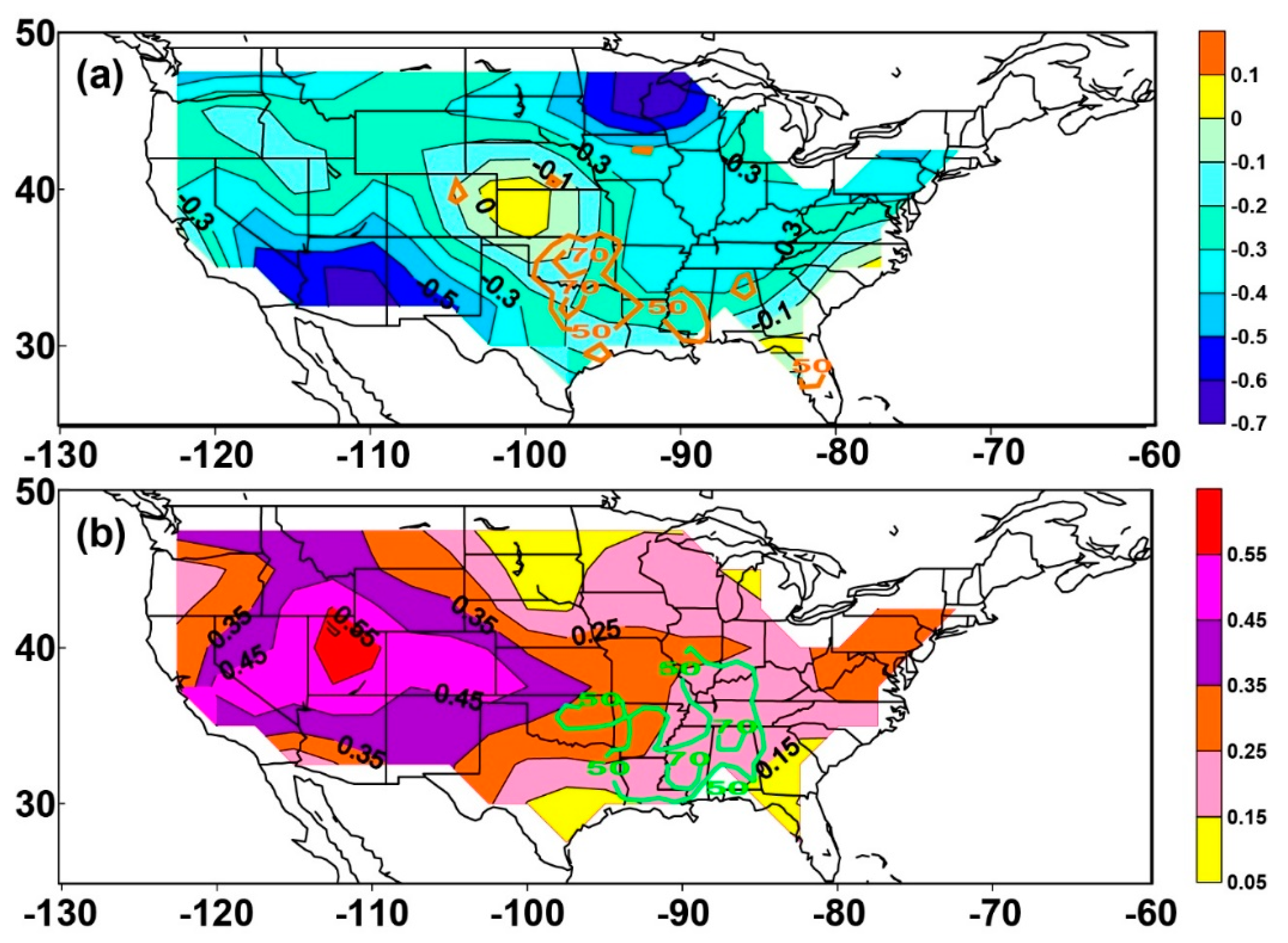

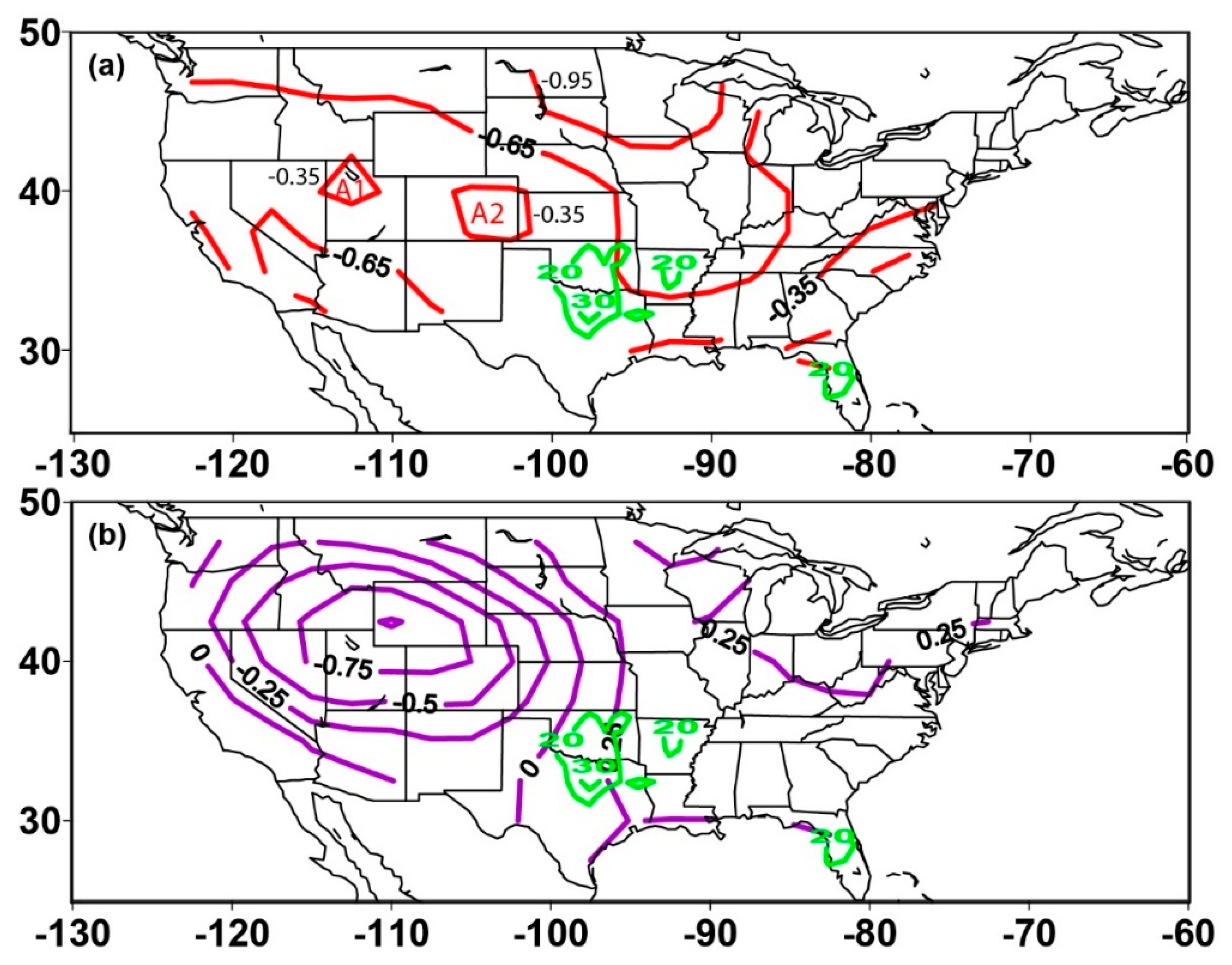
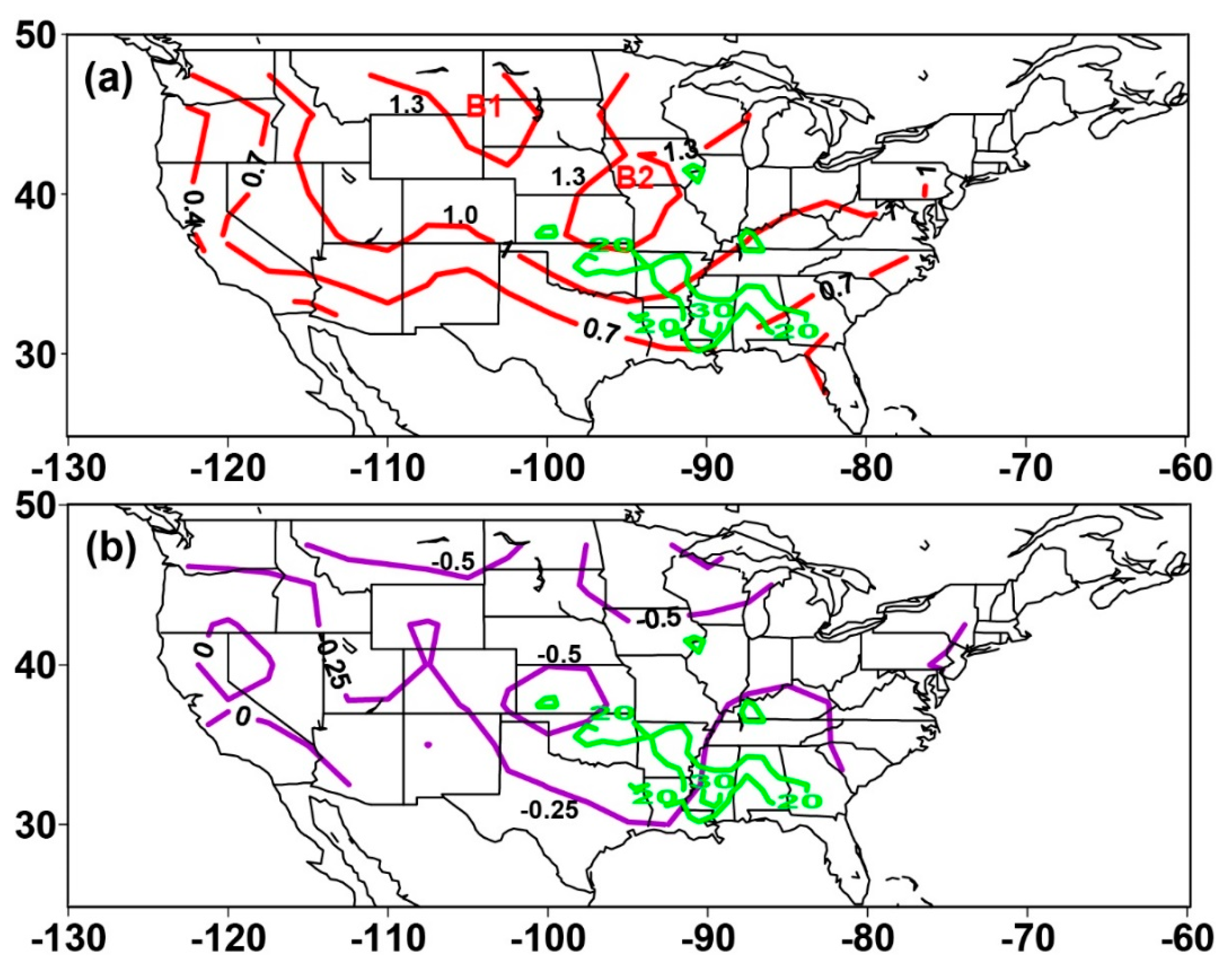
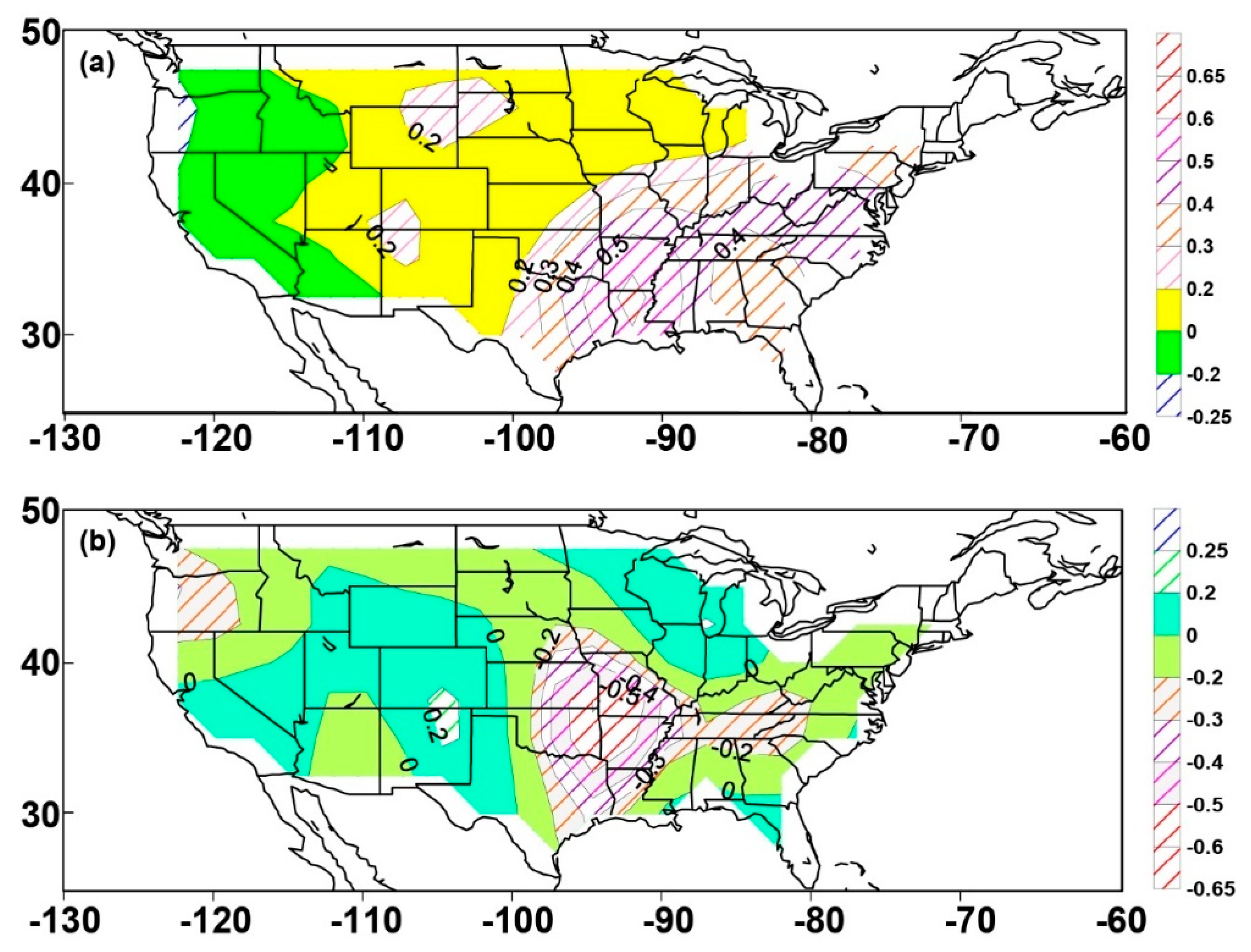
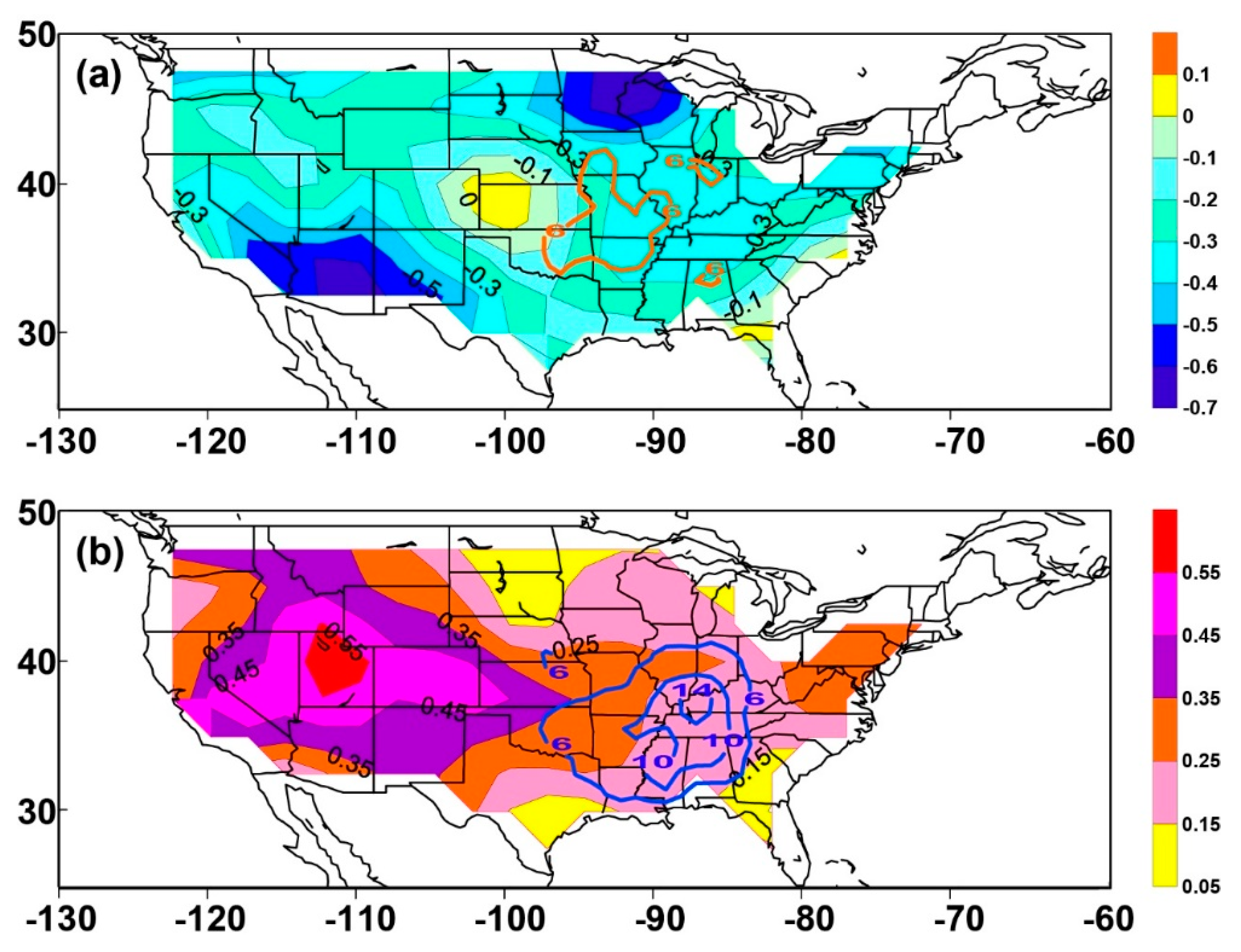

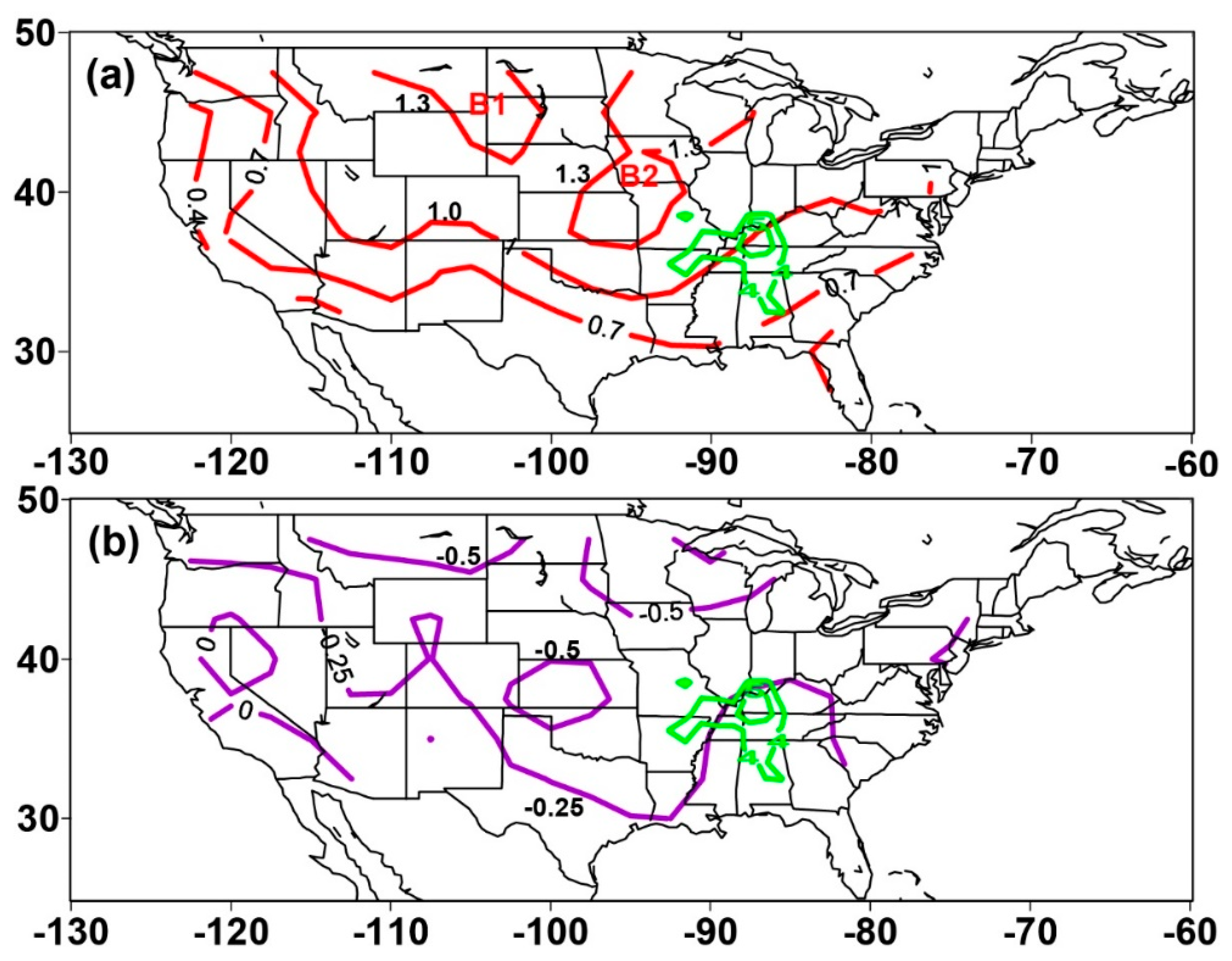

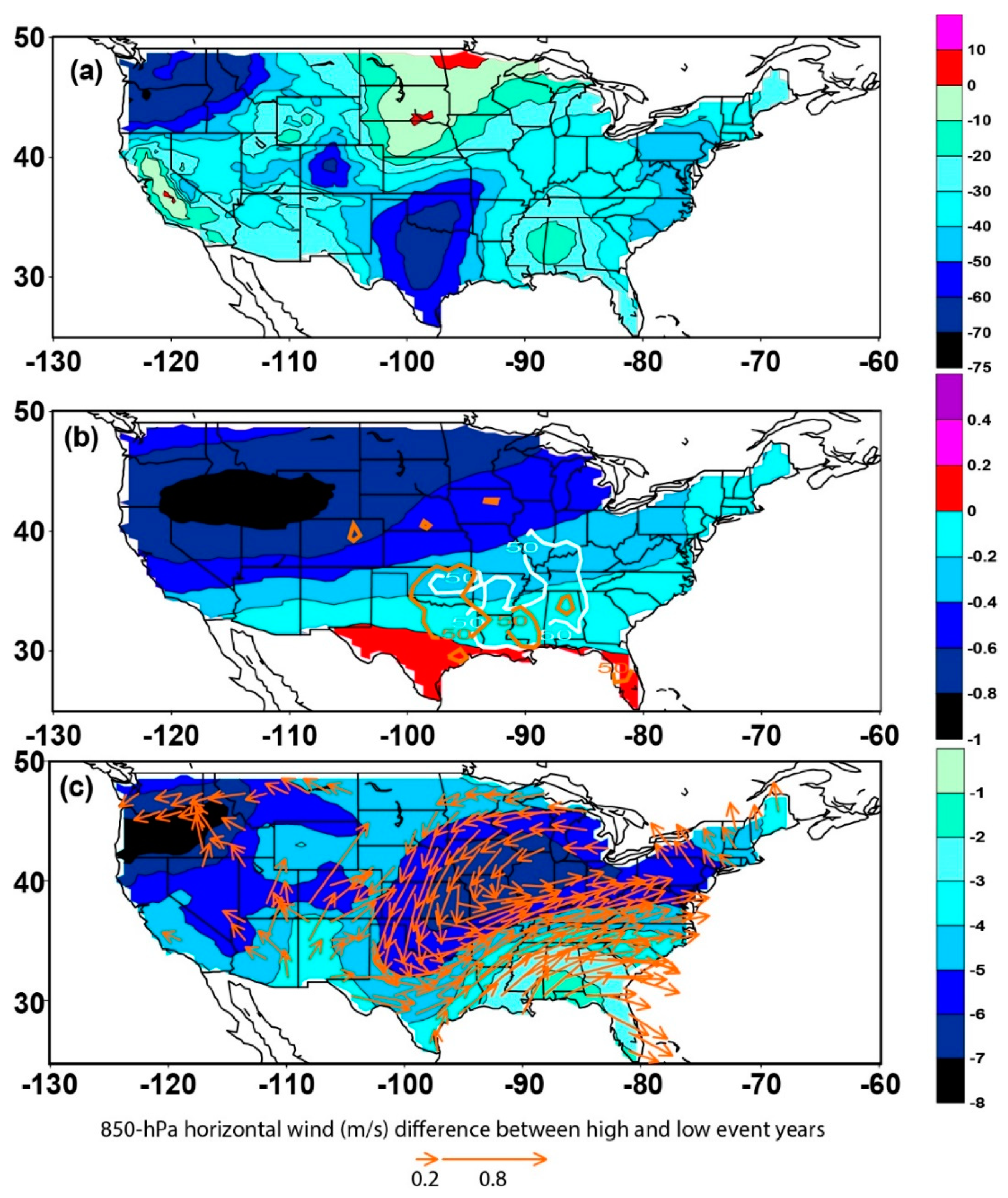

| Intensity | Speed Range (m s−1) | Median Speed (m s−1) | Weight |
|---|---|---|---|
| EF1 | 38.4–49.2 | 43.8 | 0.24 |
| EF2 | 49.6–60.4 | 55 | 0.38 |
| EF3 | 60.8–73.8 | 67.3 | 0.57 |
| EF4 | 74.2–89.4 | 81.8 | 0.84 |
| EF5 | >89.4 | 89.4 | 1.00 |
| Tornado Days | 1+ | 2+ | 5+ | 10+ | 15+ | 20+ | 25+ | 30+ | 35+ | 40+ | 45+ | 50+ |
|---|---|---|---|---|---|---|---|---|---|---|---|---|
| t statistic | 1.717 | 1.418 | 1.114 | 2.415 | 2.862 | 2.832 | 2.715 | 1.460 | 0.580 | 3.194 | 2.248 | 3.198 |
| tα | 1.960 | 1.645 | 1.645 | 1.960 | 2.576 | 2.576 | 2.576 | 1.645 | 1.645 | 2.576 | 1.960 | 2.576 |
| α | 0.05 | 0.10 | 0.10 | 0.05 | 0.01 | 0.01 | 0.01 | 0.10 | 0.10 | 0.01 | 0.05 | 0.01 |
Publisher’s Note: MDPI stays neutral with regard to jurisdictional claims in published maps and institutional affiliations. |
© 2021 by the authors. Licensee MDPI, Basel, Switzerland. This article is an open access article distributed under the terms and conditions of the Creative Commons Attribution (CC BY) license (https://creativecommons.org/licenses/by/4.0/).
Share and Cite
Cao, Z.; Cai, H.; Zhang, G.J. Geographic Shift and Environment Change of U.S. Tornado Activities in a Warming Climate. Atmosphere 2021, 12, 567. https://doi.org/10.3390/atmos12050567
Cao Z, Cai H, Zhang GJ. Geographic Shift and Environment Change of U.S. Tornado Activities in a Warming Climate. Atmosphere. 2021; 12(5):567. https://doi.org/10.3390/atmos12050567
Chicago/Turabian StyleCao, Zuohao, Huaqing Cai, and Guang J. Zhang. 2021. "Geographic Shift and Environment Change of U.S. Tornado Activities in a Warming Climate" Atmosphere 12, no. 5: 567. https://doi.org/10.3390/atmos12050567
APA StyleCao, Z., Cai, H., & Zhang, G. J. (2021). Geographic Shift and Environment Change of U.S. Tornado Activities in a Warming Climate. Atmosphere, 12(5), 567. https://doi.org/10.3390/atmos12050567








